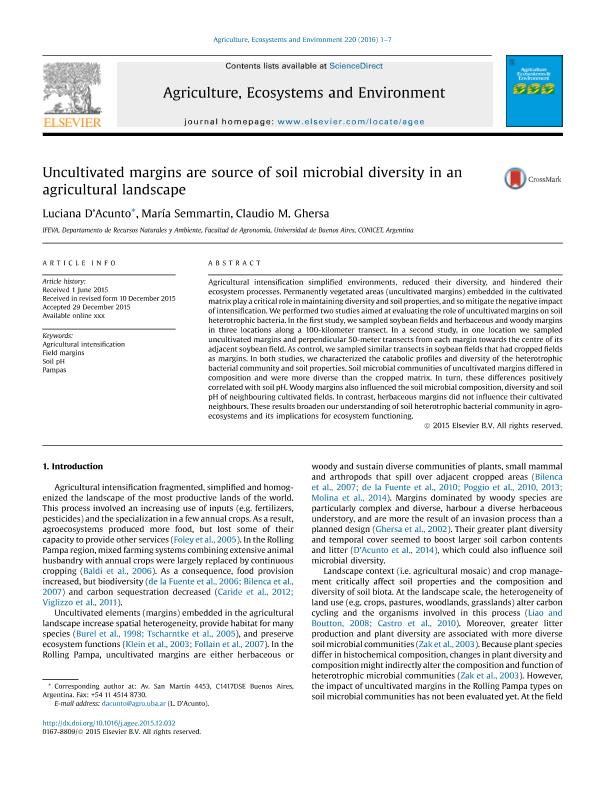Artículo
Uncultivated margins are source of soil microbial diversity in an agricultural landscape
Fecha de publicación:
15/03/2016
Editorial:
Elsevier Science
Revista:
Agriculture, Ecosystems and Environment
ISSN:
0167-8809
Idioma:
Inglés
Tipo de recurso:
Artículo publicado
Clasificación temática:
Resumen
Agricultural intensification simplified environments, reduced their diversity, and hindered their ecosystem processes. Permanently vegetated areas (uncultivated margins) embedded in the cultivated matrix play a critical role in maintaining diversity and soil properties, and so mitigate the negative impact of intensification. We performed two studies aimed at evaluating the role of uncultivated margins on soil heterotrophic bacteria. In the first study, we sampled soybean fields and herbaceous and woody margins in three locations along a 100-kilometer transect. In a second study, in one location we sampled uncultivated margins and perpendicular 50-meter transects from each margin towards the centre of its adjacent soybean field. As control, we sampled similar transects in soybean fields that had cropped fields as margins. In both studies, we characterized the catabolic profiles and diversity of the heterotrophic bacterial community and soil properties. Soil microbial communities of uncultivated margins differed in composition and were more diverse than the cropped matrix. In turn, these differences positively correlated with soil pH. Woody margins also influenced the soil microbial composition, diversity and soil pH of neighbouring cultivated fields. In contrast, herbaceous margins did not influence their cultivated neighbours. These results broaden our understanding of soil heterotrophic bacterial community in agro-ecosystems and its implications for ecosystem functioning.
Palabras clave:
Agricultural Intensification
,
Field Margins
,
Pampas
,
Soil Ph
Archivos asociados
Licencia
Identificadores
Colecciones
Articulos(IFEVA)
Articulos de INST.D/INV.FISIOLOGICAS Y ECO.VINCULADAS A L/AGRIC
Articulos de INST.D/INV.FISIOLOGICAS Y ECO.VINCULADAS A L/AGRIC
Citación
D'acunto, Luciana; Semmartin, María Gisela; Ghersa, Claudio Marco; Uncultivated margins are source of soil microbial diversity in an agricultural landscape; Elsevier Science; Agriculture, Ecosystems and Environment; 220; 15-3-2016; 1-7
Compartir
Altmétricas




